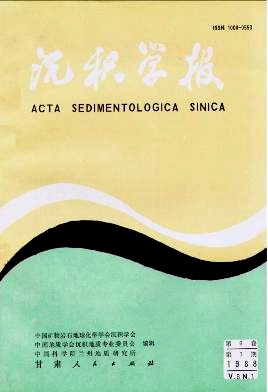GEOLOGICAL AND PROSPECTIVE SIGNIFICANCE OF THE EARLY PERMIAN,MARINE SEPIOLITE-PHASE TRANSFORMATION IN PINGXIAN-LEPING DEPRESSION
- Received Date: 1985-12-13
- Publish Date: 1988-03-10
Abstract: A rare type of marine sepiolite in China was first reported from Leping County, Jiangxi Province in 1947 (R. Zhang, 1947). In 1963, Peng Qirui founed the existence of talc and quartz associated with the sepiolite by means of DTA and XRD. In recent years, Professor R. Zhang considered the talc may be the result of the transformation of crystal structure of sepiolite underdeep buried condition (R.Zhan, 1981) R. Zhang and Z. Yang, 1985), In this paper the authors briefly summarized the achievement of sepiolite phasetransformation both in laboratory experiments and in field observations, which has been reported in publications. It is noticed that sepiolite is stable under hydrothermal condition at temperature below 310°. At higher temperature sepiolite undergoes the following transformation: sepiolite→ (stevensite)→hydrotalc→talc (+quartz). Since the associated minerals-talc, stevensite and quartz are major factors to influence the ore quality and evaluation in industry, it is important to deal with the sepiolite phase-transformation during the diagenesis processing. The phase-transformation of sepiolite in the early Permian in south China is an only example in the world, and also a nature example to study sedimentary diagenesis. The major factors of the transformation are palaeothermals, pressure and geological time. The most important factor for sepiolite to be transformed into talc is palaeo- temperature. It should be pointed out that the transformation can be taken place at lower palaeotemperature rather than 310°C which obtained from the artifical experiments. A sensible way to determine the palaeotemperature under buried condition is the degree of coalification of the Permian coal seams (Table 1,2). The reflectance of vitrinite is particularly useful since measurements need not be confined to coal, but can be undertaken on other sediments which contain plant fragments preserved as vitrinite. So, vitrinite reflectance in the Permian sedimentary rocks can be used as an indication of burial temperature reached by sepiolite. According to the vitrinite reflectance (Table 3), the authors suggest that the favourable diagenetic temperature for the transformation is below 120°C. Based on the regional distribution of the Permian coal rank, the authors consider that the sepiolite phase- transformation shows a synchronous relationship with coal metamorphism. It can be shown that the distibution areas of the lower rank of coal (subbituminous coal) conform evidently to those of sepiolite on the map of the trend surface analysis (Fig. 4 , ) by means of the computer VICTOR-9000. Therefore, the geological, prospective significance of the phase-transformation for sepiolite lies in the possibility for predicting the existing regions of sepiolite based on the lower rank of coal.
| Citation: | Yang Zhenqiang, Chen Shangqin, Xu Junwen. GEOLOGICAL AND PROSPECTIVE SIGNIFICANCE OF THE EARLY PERMIAN,MARINE SEPIOLITE-PHASE TRANSFORMATION IN PINGXIAN-LEPING DEPRESSION[J]. Acta Sedimentologica Sinica, 1988, 6(1): 88-96. |






 DownLoad:
DownLoad: